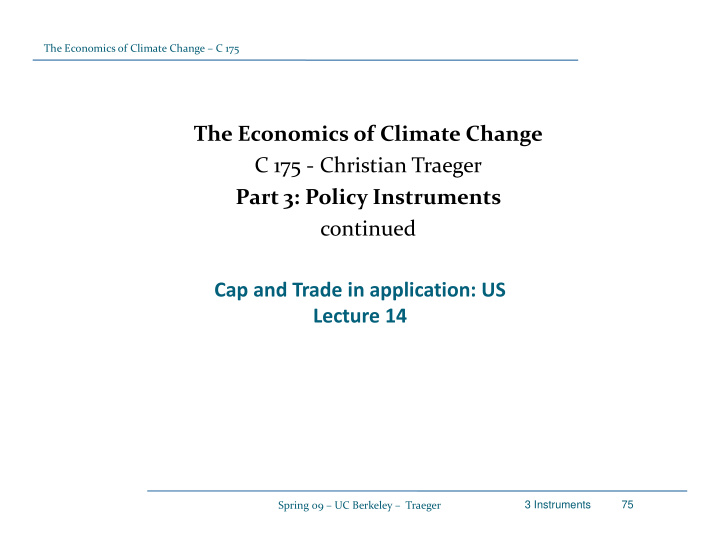



The Economics of Climate Change – C 175 The Economics of Climate Change C 175 ‐ Christian Traeger 75 g Part 3: Policy Instruments continued Cap and Trade in application: US Lecture 14 Lecture 14 Spring 09 – UC Berkeley – Traeger 3 Instruments 75
The Economics of Climate Change – C 175 US: Some non ‐ GHG Cap & Trade Programs Acid Rain Trading (U.S. EPA), SO2, Electricity Generation, 1995–Present Northeast NOX Budget Trading & NOx SIP Call (U.S. EPA), NOx in the US Northeast, Stationary Sources, 1999–2003 ‐ Present N h S i S P RECLAIM (South Coast Quality Management District), NOx and SO2 in LA Basin, Stationary sources, 1994–Present Locally: NOx: formation of ozone or smog, which can affect human respiratory NO f i f hi h ff h i health. SO2: can cause or contribute to fine particulate matter pollution, which inhibits visibility and can affect human respiratory health h b b l d ff h h l h So locally both related to: Asthma, Allergies, and Chronical lung diseases Regional: Both causes of acid rain affecting plants/forests and aquatic Regional: Both causes of acid rain affecting plants/forests and aquatic animals Spring 09 – UC Berkeley – Traeger 3 Instruments 76
The Economics of Climate Change – C 175 EU emissions trading compared to US NOx and SO2 Source: Kruger / Pizer 2004 Spring 09 – UC Berkeley – Traeger 3 Instruments 77
The Economics of Climate Change – C 175 US Cap & Trade for GHGs – a recent national attempt Failed (in senate 2007/2008): Lieberman ‐ Warner Climate Security Act Cap & Trade with reduction of 63% below 2005 levels by 2050 Initial allocation in 2012 Freely allocated allowances: 73.5% Auction: 26.5% Banking –Unlimited banking of allowances B ki U li it d b ki f ll Borrowing –15% of annual compliance obligation can be borrowed from future years at a 10% interest rate Spring 09 – UC Berkeley – Traeger 3 Instruments 78
The Economics of Climate Change – C 175 US Cap & Trade for GHGs – Regional iniciatives After failure of federal cap & trade initiative initiative, states formed several regional initiatives to initiatives to introduce cap & trade for GHG reduction Some of them collaborate also with Canadian with Canadian provinces Spring 09 – UC Berkeley – Traeger 3 Instruments 79
The Economics of Climate Change – C 175 US Cap & Trade for GHGs – RGGI Regional Greenhouse Gas Initiative (RGGI) First mandatory U.S. cap ‐ and ‐ trade program for carbon dioxide begin by capping emissions at current levels in 2009, and then reducing emissions 10% by 2019 covers power plants of at least 25 megawatts that burn more than 50% covers power plants of at least 25 megawatts that burn more than 50% fossil fuel Banking: Yes Borrowing: No CO 2 Allowance Prices: Auction 1: 9/2008 $3 07 Auction 1: 9/2008 $3.07 Auction 2: 12/2008 $3.38 Next Auction: 3/18/2009 Auction large fraction (must auction 25%, most states auction 100%) Spring 09 – UC Berkeley – Traeger 3 Instruments 80
The Economics of Climate Change – C 175 US Cap & Trade for GHGs – WCI Western Climate Initiative (WCI) 7 U.S. states and 4 Canadian provinces 7 4 p + observers (light blue) GHG target: 15 percent below 2005 levels by 2020 Will cover 90% of GHG emissions when fully implemented. Will % f GHG i i h f ll i l d 1 st phase: starts 2012, will cover emissions from electricity and large industrial and commercial sources 2 nd phase: starts 2015, will expand to cover emissions from transportation and residential, commercial, and industrial fuel use not otherwise covered Start with auctioning at least 25% and increase share over time Banking: Yes Borrowing: No Spring 09 – UC Berkeley – Traeger 3 Instruments 81
The Economics of Climate Change – C 175 US Cap & Trade for GHGs ‐ MGGRA Midwest Greenhouse Gas Reduction Accord (MGGRA) Long ‐ term targets 60 ‐ 80% below current emissions Multi ‐ sector cap & trade Details expected soon Implementation should begin 2010 Spring 09 – UC Berkeley – Traeger 3 Instruments 82
The Economics of Climate Change – C 175 An example of standards: CAFE Corporate Average Fuel Economy (CAFE) Set by US Environmental Protection Agency (EPA) Sets fuel efficiency standards for miles per gallon (mpg) regulates passenger cars and (now) light trucks Fleet average is calculated as production weighted harmonic mean ‐ > produces lower mean than arithmetic (standard) mean ‐ > …?... Manufacturer’s pay fine per (deci ‐ ) mpg under the standard and car in the fleet Law was passed in response to Arab oil embargo in 1975 Law was passed in response to Arab oil embargo in 1975 Standard had increased over time (and declared plans to increase further) Spring 09 – UC Berkeley – Traeger 3 Instruments 83
Recommend
More recommend